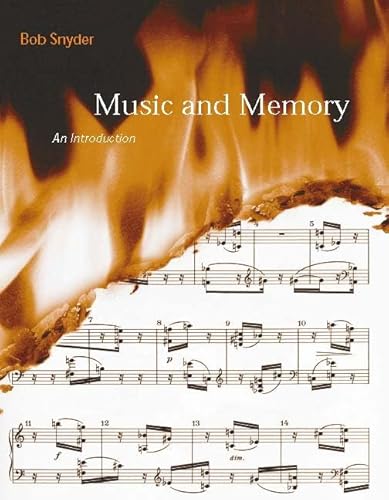Items related to Music and Memory: An Introduction

Synopsis
This far-ranging book shows how human memory influences the organization of music. The book is divided into two parts. The first part presents basic ideas about memory and perception from cognitive psychology and, to some extent, cognitive linguistics. Topics include auditory processing, perception, and recognition. The second part describes in detail how the concepts from the first part are exemplified in music. The presentation is based on three levels of musical experience: event fusion (the formation of single musical events from acoustical vibrations in the air, on a time scale too small to exhibit rhythm), melody and rhythm, and form. The focus in the latter is on the psychological conditions necessary for making large-scaleóthat is, formalóboundaries clear in music rather than on traditional musical forms. The book also discusses the idea that much of the language used to describe musical structures and processes is metaphorical. It encourages readers to consider the possibility that the process of musical composition can be "a metaphorical transformation of their own experience into sound."
The book also touches on unresolved debates about psychological musical universals, information theory, and the operation of neurons. It requires no formal musical training and contains a glossary and an appendix of listening examples.
"synopsis" may belong to another edition of this title.
About the Author
Bob Snyder is a composer and video artist and Chair of the Sound Program at the School of the Art Institute of Chicago.
"About this title" may belong to another edition of this title.
US$ 3.75 shipping within U.S.A.
Destination, rates & speedsSearch results for Music and Memory: An Introduction
Music and Memory: An Introduction
Seller: HPB-Red, Dallas, TX, U.S.A.
Paperback. Condition: Good. Connecting readers with great books since 1972! Used textbooks may not include companion materials such as access codes, etc. May have some wear or writing/highlighting. We ship orders daily and Customer Service is our top priority! Seller Inventory # S_412578031
Quantity: 1 available
Music and Memory: An Introduction
Seller: BooksRun, Philadelphia, PA, U.S.A.
Paperback. Condition: Good. Ship within 24hrs. Satisfaction 100% guaranteed. APO/FPO addresses supported. Seller Inventory # 0262692376-11-1
Quantity: 2 available
Music and Memory: An Introduction
Seller: Tim's Used Books Provincetown Mass., Provincetown, MA, U.S.A.
Soft cover. Condition: Very Good. No marks in text. Not a library book. Ships in a cardboard enclosure, with tracking. Tim's Used Books, open shop in Provincetown USA, buying and selling good books at fair prices on the same spot since 1991. Got books? Reach out! Thank you. Seller Inventory # 2451516
Quantity: 1 available
Music and Memory: An Introduction
Seller: Textbooks_Source, Columbia, MO, U.S.A.
paperback. Condition: Good. Ships in a BOX from Central Missouri! May not include working access code. Will not include dust jacket. Has used sticker(s) and some writing or highlighting. UPS shipping for most packages, (Priority Mail for AK/HI/APO/PO Boxes). Seller Inventory # 000525239U
Quantity: 1 available
Music and Memory : An Introduction
Seller: Better World Books, Mishawaka, IN, U.S.A.
Condition: Very Good. 1 Edition. Former library book; may include library markings. Used book that is in excellent condition. May show signs of wear or have minor defects. Seller Inventory # 18365942-75
Quantity: 1 available
Music and Memory : An Introduction
Seller: Better World Books, Mishawaka, IN, U.S.A.
Condition: Very Good. 1 Edition. Used book that is in excellent condition. May show signs of wear or have minor defects. Seller Inventory # 49733345-6
Quantity: 1 available
Music and Memory
Seller: Bookbot, Prague, Czech Republic
Condition: Fine. Leichte Abnutzungen; Gebogener Buchrucken. This far-ranging book shows how human memory influences the organization of music. The book is divided into two parts. The first part presents basic ideas about memory and perception from cognitive psychology and, to some extent, cognitive linguistics. Topics include auditory processing, perception, and recognition. The second part describes in detail how the concepts from the first part are exemplified in music. The presentation is based on three levels of musical event fusion (the formation of single musical events from acoustical vibrations in the air, on a time scale too small to exhibit rhythm), melody and rhythm, and form. The focus in the latter is on the psychological conditions necessary for making large-scale--that is, formal--boundaries clear in music rather than on traditional musical forms. The book also discusses the idea that much of the language used to describe musical structures and processes is metaphorical. It encourages readers to consider the possibility that the process of musical composition can be "a metaphorical transformation of their own experience into sound." The book also touches on unresolved debates about psychological musical universals, information theory, and the operation of neurons. It requires no formal musical training and contains a glossary and an appendix of listening examples. Seller Inventory # 6f1f4072-7f1a-47ad-b1f7-9e01c9f7ab0e
Quantity: 1 available
Music and Memory: An Introduction
Seller: medimops, Berlin, Germany
Condition: good. Befriedigend/Good: Durchschnittlich erhaltenes Buch bzw. Schutzumschlag mit Gebrauchsspuren, aber vollstšndigen Seiten. / Describes the average WORN book or dust jacket that has all the pages present. Seller Inventory # M00262692376-G
Quantity: 1 available
Music & Memory ‚" An Introduction (A Bradford Book)
Seller: WorldofBooks, Goring-By-Sea, WS, United Kingdom
Paperback. Condition: Very Good. The book has been read, but is in excellent condition. Pages are intact and not marred by notes or highlighting. The spine remains undamaged. Seller Inventory # GOR002968774
Quantity: 1 available
Music and Memory: An Introduction
Seller: Toscana Books, AUSTIN, TX, U.S.A.
Paperback. Condition: new. Excellent Condition.Excels in customer satisfaction, prompt replies, and quality checks. Seller Inventory # Scanned0262692376
Quantity: 1 available

